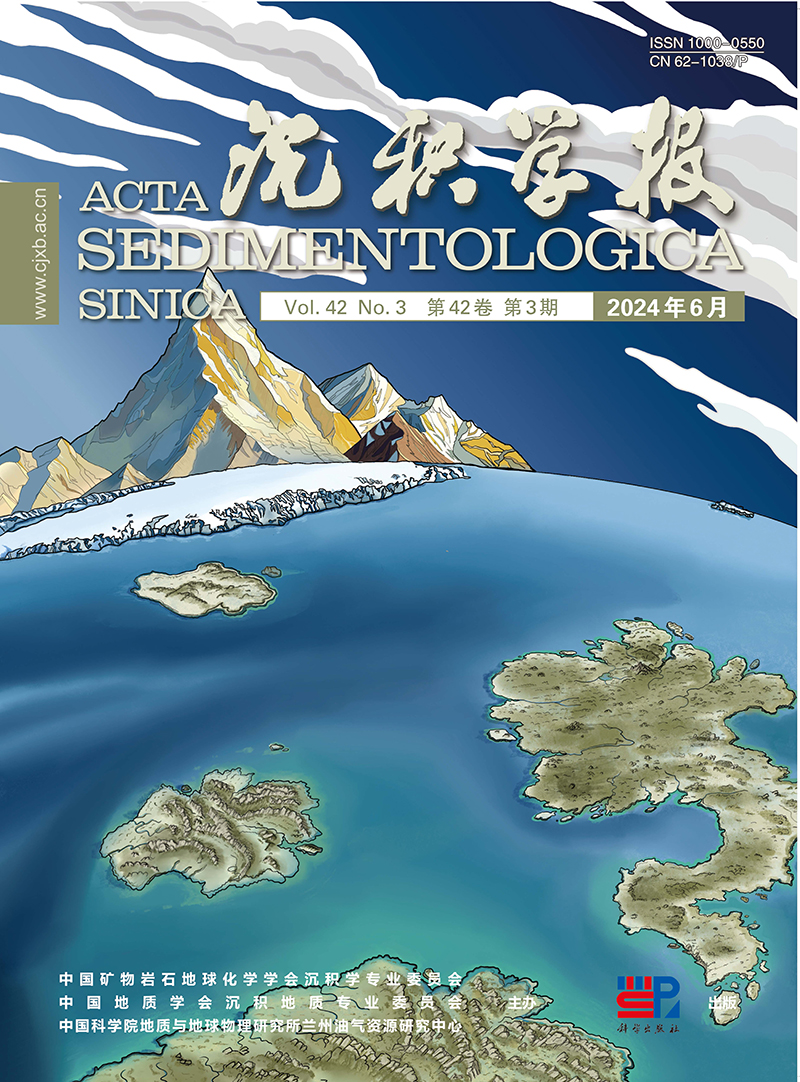HTML
-
灯影组是四川盆地油气勘探和研究最重要的层位之一,尤其是2010年以来绵阳—长宁拉张槽东侧的安岳气田和北斜坡含气区相继发现进一步证实了灯影组广阔的勘探前景[1⁃2]。目前,灯影组的勘探仍主要围绕拉张槽开展[2],如何在拉张槽之外的广阔区域找到油气接替区是难点问题。过去的研究表明,灯影组优质储层的发育明显受岩相/沉积相控制,微生物白云岩(微生物纹层白云岩、叠层石白云岩、凝块石白云岩等)以及其打碎形成的砂屑白云岩储集性明显好于泥晶白云岩等其他岩石类型[3⁃4]。因此,准确识别灯影组各种岩相的沉积环境,建立碳酸盐岩台地结构及演化过程,明确有利储集相带时空分布规律,将为灯影组油气勘探领域的拓展提供重要参考。
除了扬子东南缘的南华盆地及鄂西海槽等少数硅质岩、灰岩沉积区外,在整个中上扬子地区灯影组几乎都是以白云岩沉积为主[5⁃6]。过去已有大量的沉积相、油气地质研究围绕四川盆地内部的勘探热点地区开展,揭示了微生物丘滩为储层发育有利相带[2⁃4,7⁃10]。然而,放眼整个中上扬子地区,灯影组沉积期碳酸盐岩台地结构及有利储集相带发育分布规律尚不明确,制约了勘探领域由绵阳—长宁拉张槽两侧向其余广大地区拓展[1⁃2]。最新的研究基本肯定了中上扬子地区两台(上扬子台地、中扬子台地)夹一槽(鄂西海槽)的沉积格局,但不同学者刻画古地理展布差异明显[5⁃6,11⁃12],需要进一步的平面上研究工作加以验证和完善。近年来的研究认为四川盆地灯影组丘滩相微生物岩为有利储集岩[3,7]。目前,中上扬子地区灯影组沉积相带发育及迁移规律尚不明确,以至于不同学者在有利储集相带平面分布上难以形成统一认识[7,11⁃12]。此外,灯影组台内和台缘的岩相特征及差异仍然存在争议:(1)经典的碳酸盐岩台地模式及灯影组同期的碳酸盐岩台地研究表明台缘带以高能的砂屑、鲕粒白云岩为特征[5,13⁃16],而四川盆地及周缘地区灯影组以微生物白云岩、泥晶白云岩为主,缺少典型的台缘相标志;(2)越来越多的证据表明绵阳—长宁拉张槽中段—南段主要为侵蚀成因[10]。拉张槽的侵蚀成因并不支持台缘丘滩相在四川盆地内部广泛发育。为了解决上述问题,基于数十条灯影组剖面及钻井[5⁃6](图1),重点解析横穿台内—盆地方向上的岩相纵横向变化,以重建灯影组沉积期中上扬子台地相带结构及迁移过程,并进一步明确有利储集相带的时空分布规律。

Figure 1. Paleogeographic map of the Middle⁃Upper Yangtze area during the deposition of the Dengying Formation and distribution of main sections (well) (modified from reference [6])
-
研究区位于扬子地块西部和中部的中上扬子地区(图1)。通常认为扬子地块在新元古代早期与华夏地块碰撞,形成了统一的华南板块[17]。此后,伴随着Rodinia超大陆的裂解,华南板块内部经历了强烈的裂谷作用,呈现出地堑地垒格局[18⁃20]。经过成冰纪—早震旦世的填平补齐,中上扬子地区地貌高差减小,为碳酸盐岩台地的建立打下基础[19⁃21]。到了晚震旦世灯影组沉积期,中上扬子地区总体上继承了裂谷期形成的北西高、南东低沉积面貌:西部和东部分别发育上扬子台地和中扬子台地,两台地间被鄂西海槽分隔;台地东南缘为南华盆地,以硅质岩沉积为特征[5⁃6](图1)。上扬子台地具有明显的陆表海镶边碳酸盐岩台地特征,高能丘滩相带环台地边缘发育[6,12]。中扬子台地表现为非对称的孤立台地,西缘宜昌地区呈现缓坡形态,南缘张家界地区表现为镶边台地,高能丘滩相带沿台地(内缓坡)边缘带状发育[5]。研究区北西高、南东低的沉积古地貌进一步控制了岩石地层的发育(图2)。在南华盆地中,下震旦统陡山沱组常与成冰系冰碛岩整合接触,岩性以页岩与碳酸盐岩互层为主,朝台地方向碳酸盐岩比例增加,并在台地边缘发育富磷夹层[19,22]。在上扬子地区的古陆周缘,陡山沱组通常超覆到基底之上,并相变为一套以砂岩、泥岩为主的地层,称为观音崖组[22]。灯影组与下伏陡山沱组整合接触,在中上扬子台地上以碳酸盐岩为主,往古陆方向碎屑岩夹层增加,向南华盆地转变为留茶坡组硅质岩[5⁃6,22]。

Figure 2. Stratigraphic framework of the Upper Cryogenian to Lower Cambrian at the Middle⁃Upper Yangtze area (modified from reference [6])
在上扬子台地相区,灯影组自下而上可进一步划分为四个岩相段:灯一段以泥晶白云岩为主,偶见砂屑、鲕粒白云岩;灯二段中下部发育多种微生物白云岩并伴生葡萄状构造,之上以泥晶白云岩夹微生物白云岩为特征;灯三段以富含陆源碎屑为特征;灯四段下部以泥晶白云岩为主,上部微生物白云岩增加[6,22]。中扬子三峡地区,灯影组自下而上可以划分为蛤蟆井段、石板滩段和白马沱段,总体表现为两套白云岩夹一套灰岩[5,22]。其中,蛤蟆井段、白马沱段岩性主要为颗粒白云岩及微生物白云岩;石板滩段发育薄板状灰岩,偶夹颗粒白云岩及微生物白云岩,与蛤蟆井段、白马沱段呈楔状展布,具有向台内方向尖灭,朝鄂西海槽方向厚度比例增加的趋势[5]。灯影组可以划分为2.5个层序:上扬子地区灯一段—灯二段中下部构成层序1海退体系域,灯二段上部发育微生物白云岩—泥晶白云岩—微生物白云岩的海侵—海退旋回组成层序2,灯三段碎屑岩和灯四段泥晶白云岩—微生物白云岩序列分别构成层序3海侵体系域和海退体系域[6];中扬子三峡地区层序1海退体系域以蛤蟆井段颗粒白云岩、微生物白云岩为代表,石板滩段的灰岩及其中颗粒白云岩夹层构成层序2海侵—海退体系域及层序3海侵体系域,白马沱段的颗粒白云岩及微生物白云岩构成层序3海退体系域[5]。受桐湾运动及全球海平面下降影响,在整个中上扬子地区灯影组顶部普遍发育不整合面,其上的寒武系纽芬兰统(如麦地坪组、岩家河组等)在台地上缺失严重,以灰岩、白云岩及磷块岩沉积为主,在周缘的盆地相区转换为连续的留茶坡组硅质岩沉积[5⁃6,22⁃23]。在随后的大幅海侵背景下,中上扬子地区广泛发育黑色页岩(如牛蹄塘组、水井沱组),该套页岩向古陆方向砂质含量增加[17,22⁃23]。
-
除了上扬子地区灯三段可见混合沉积,中扬子三峡地区石板滩段可见灰岩之外,灯影组在中上扬子台地相区几乎均发育白云岩。鉴于石板滩段灰岩为风暴影响的中—外缓坡沉积,留茶坡组硅质岩属于斜坡—盆地相沉积已经得到学界广泛认同,前人据此分别在中、上扬子地区建立了缓坡台地和陆表海碳酸盐岩台地沉积模式[5⁃6,22⁃23],本文着重解析灯影组沉积期碳酸盐岩台地相(或内缓坡)的白云岩岩相组合变化。通过综合分析研究区30余条剖面(钻井),发现灯影组沉积期上扬子台地和中扬子台地具有类似的岩相组合(表1),可以大体归纳为三种沉积相带:(1)丘滩相,以发育块状鲕粒白云岩、砂屑白云岩及丘状叠层石建造为标志;(2)潮坪相,以微生物纹层白云岩、穹窿—缓波状叠层石白云岩、凝块石白云岩等微生物岩形成的米级、分米级旋回为特征;(3)潟湖相,主要发育泥晶(泥质)白云岩、含球粒/砂屑泥晶白云岩及泥晶砂质白云岩(表2)。丘滩相大致沿前人刻画的碳酸盐岩台地—斜坡(内—中缓坡)边界分布[5⁃6,12]:在上扬子地区该种相带主要发育在灯影组下部灯一段(如蓬探1井、资阳1井、清平剖面、北斗山剖面),在梅子湾、白家坝和鱼鳞剖面[24]发育于灯二段,在岩孔—松林地区灯一段—灯二段均有发育;中扬子地区该种相带在部分剖面发育于灯影组下部的蛤蟆井段(如三岔、白鹭垭、田坪剖面)或上部的白马沱段(如庙河剖面),不少剖面可见该种相带反复进积—退积,多次出现在灯影组不同部位(如白果坪、晓峰河、灯影峡、武山、薛家店[25]及邓家崖剖面[26])(图1)。潮坪和潟湖相广泛分布在中上扬子碳酸盐岩台地上,在绝大部分剖面/钻井(除鱼鳞剖面、庙河剖面、ZK102井外)均有发育(图1)。这两种相带的分布范围与葡萄状白云岩的分布范围大致一致,本次研究剖面/钻井灯二段中下部(或相应层段)发育这两种相带的层段基本伴生了葡萄状构造(图1)。
剖面(井) 位置(坐标) 地层及沉积环境 杨坝 四川南江(32°28′35″ N,106°46′59″ E) 灯一、灯二、灯四段均发育潮坪—潟湖相,灯二段发育葡萄状白云岩 关山 陕西勉县(33°11′8″ N,106°36′40″ E) 灯影组零星出露,发育潮坪—潟湖相 胡家坝 陕西宁强(32°56′58″ N,106°28′20″ E) 灯一、灯二、灯四段均发育潮坪—潟湖相,灯二段发育葡萄状白云岩 福成 四川南江(32°30′21″ N,107°15′24″ E) 灯二、灯四段主要发育潮坪—潟湖相 白家坝 四川南江(32°24′52″ N,107°58′32″ E) 灯二、灯四段主要发育潮坪—潟湖相 马深1井 四川通江(32°10′11″ N,107°10′57″ E) 灯二、灯四段主要发育潮坪—潟湖相 康家坪 四川城口(31°43′26″ N,109°7′42″ E) 灯一、灯二、灯四段均发育潮坪—潟湖相,灯二段发育葡萄状白云岩 鱼鳞 重庆巫溪(31°40′19″ N,109°28′47″ E) 灯影组全段以斜坡—盆地相为主,仅在灯二段上部发育丘滩相 廖家槽 重庆彭水(29°44′14″ N,108°14′11″ E) 剥蚀后仅残留灯一—灯二段,为潮坪—潟湖相,灯二段发育葡萄状白云岩 松林 贵州遵义(27°43′11″ N,106°42′13″ E) 剥蚀后仅残留灯一—灯二段,发育潮坪—潟湖相为主,仅在灯一段下部发育斜坡相,中部和灯二段顶部发育丘滩相,灯二段发育葡萄状白云岩 岩孔 贵州金沙(27°34′14″ N,106°14′58″ E) 剥蚀后仅残留灯二段,发育潮坪—潟湖相为主,仅在中上部发育丘滩相,灯二段发育葡萄状白云岩 北斗山 贵州瓮安(27°0′47″ N,107°23′10″ E) 剥蚀后仅残留灯一—灯二段,灯一段下部为斜坡相,上部发育丘滩相, 灯二段发育潮坪—潟湖相,灯二段发育葡萄状白云岩 梅子湾 贵州金沙(27°27′22″ N,107°26′29″ E) 剥蚀后仅残留灯一—灯二段相应层位,以斜坡相为主,仅在剖面上部发育丘滩相 谷腊 贵州清镇(26°42′26″ N,106°28′55″ E) 剥蚀后仅残留灯一—灯二段,为潮坪—潟湖相,灯二段发育葡萄状白云岩 方深1井 贵州大方(27°15′35″ N,105°38′51″ E) 灯一、灯二、灯四段主要发育潮坪—潟湖相,灯二段发育葡萄状白云岩 银厂坡 云南会泽(26°30′55″ N,103°12′45″ E) 灯影组零星出露,发育潮坪—潟湖相,灯二段发育葡萄状白云岩 棉沙湾 四川巧家(27°7′39″ N,102°55′59″ E) 灯一、灯二、灯四段均发育潮坪—潟湖相,灯二段发育葡萄状白云岩 先锋 四川峨边(29°18′28″ N,103°27′48″ E) 灯一、灯二、灯四段均发育潮坪—潟湖相,灯二段发育葡萄状白云岩 孔玉 四川康定(30°30′58″ N,102°5′5″ E) 剥蚀后仅残留灯一—灯二段,为潮坪—潟湖相,灯二段发育葡萄状白云岩 清平 四川绵竹(31°36′3″ N,104°5′12″ E) 灯一段下部为斜坡相,上部发育丘滩相,灯二、灯四段均潮坪—潟湖相,灯二段发育葡萄状白云岩 资阳1井 四川资阳(30°2′11″ N,105°0′5″ E) 剥蚀后仅残留灯一段,以潮坪—潟湖相为主,下部发育丘滩相 高石1井 四川安岳(30°2′39″ N,105°28′15″ E) 灯一、灯二、灯四段均发育潮坪—潟湖相,灯二段发育葡萄状白云岩 蓬探1井 四川大英(30°27′55″ N,105°16′23″ E) 剥蚀后仅残留灯一—灯二段,以潮坪—潟湖相为主,灯一段下部发育丘滩相,灯二段发育葡萄状白云岩 蓬探101井 四川遂宁(30°26′43″ N,105°19′26″ E) 剥蚀后仅残留灯一—灯二段,为潮坪—潟湖相,灯二段发育葡萄状白云岩 三岔 湖南张家界(29°4′28″ N,110°33′53″ E) 剥蚀后仅残留蛤蟆井段,以丘滩相为主,上部发育潮坪—潟湖相 田坪 湖南张家界(28°58′21″ N,110°24′31″ E) 剥蚀后仅残留蛤蟆井段,以丘滩相和斜坡相交替发育为特征 ZK102 贵州松桃(28°7′48″ N,108°52′48″ E) 灯影组全段以斜坡—盆地相为主 白果坪 湖北鹤峰(29°53′40″ N,110°27′47″ E) 灯影组全段以潮坪—潟湖相为主,石板滩段中部见中—外缓坡相,上部见丘滩相 灯影峡 湖北宜昌(30°47′40″ N,111°9′22″ E) 蛤蟆井段发育丘滩相,石板滩段发育中—外缓坡相、丘滩相、潮坪—潟湖、中—外缓坡相序列, 白马沱段下部发育丘滩相,上部发育潮坪—潟湖相 庙河 湖北宜昌(30°53′54″ N,110°52′34″ E) 灯影组以中—外缓坡相为主,仅白马沱段发育丘滩相 晓峰河 湖北宜昌(30°56′16″ N,111°17′47″ E) 灯影组全段以潮坪—潟湖相为主,底部,中下部,中部发育三套丘滩相,灯影组中下部发育葡萄状白云岩 白鹭垭 湖北宜昌(31°18′37″ N,111°12′36″ E) 灯影组全段以潮坪—潟湖相为主,底部,中下部,中部发育三套丘滩相,灯影组中下部发育葡萄状白云岩 鄂参1 湖北神恩施(30°14′58″ N,109°20′20″ E) 灯影组发育中—外缓坡相 西蒿坪 湖北房县(31°52′8″ N,110°39′48″ E) 灯影组零星出露,发育潮坪—潟湖相,灯影组中下部发育葡萄状白云岩 Table 1. Stratigraphy and depositional facies of typical sections (wells) of the Dengying Formationin the Middle⁃Upper Yangtze area (modified from reference [6])
相带 岩相类型 沉积特征 沉积环境 组合方式 丘滩相 鲕粒白云岩 冲刷面、交错层理 台地边缘/内缓坡浅水潮下 三种岩相类型交替叠置产出 砂屑白云岩 冲刷面、交错层理 台地边缘/内缓坡浅水潮下 丘状叠层石白云岩 呈块状—丘状 台地边缘/内缓坡浅水潮下 潮坪相 微生物纹层白云岩 鸟眼、帐篷、干缩角砾 局限台地/内缓坡潮间—潮上 凝块石白云岩→穹窿—缓波状叠层石白云岩→微生物纹层白云岩 穹窿—缓波状叠层石 白云岩 鸟眼、帐篷、干缩角砾 局限台地/内缓坡潮间—潮上 凝块石白云岩 斑块状结构, 中层状或透镜状 局限台地/内缓坡潮下 砂屑白云岩 冲刷面、滞留沉积 局限台地/内缓坡潮道 切入微生物白云岩及泥晶白云岩之中 潟湖相 泥晶(泥质)白云岩 水平层理 局限台地/内缓坡潮下 与潮坪相微生物白云岩在垂向上叠置出现, 向上过渡为潮坪相微生物白云岩形成米级旋回 含球粒/砂屑泥晶白云岩 水平层理 局限台地/内缓坡潮下 泥晶砂质白云岩 粒序层序、 丘状交错层理 局限台地/内缓坡潮下 Table 2. Lithofacies types and depositional facies of the Dengying Formation in the Middle⁃Upper Yangtze area
-
丘滩相主要出现在内缓坡及台地边缘(图1),发育三种岩石类型:鲕粒白云岩、砂屑白云岩及叠层石白云岩。这三种岩相均是以块状产出为主,最大单层厚度可达十米(图3a,b)。相对于鲕粒白云岩和砂屑白云岩,叠层石白云岩的分布更为局限且更靠近斜坡方向,仅见于北斗山、田坪等少数剖面。纵向上,在北斗山剖面可见颗粒白云岩与叠层石白云岩呈交替式叠置产出。鲕粒白云岩及砂屑白云岩的颗粒直径通常集中在0.5~2 mm,局部可达细砾级(>2 mm),分选和圆度均较好,颗粒支撑为主,颗粒间发育栉壳状白云石、粒状白云石两世代胶结物(图3c~e)。栉壳状白云石呈等厚环边状沿缝壁生长(图3e),为典型的海底胶结物;粒状白云石在栉壳状白云石基础上进一步向孔洞中心充填,为埋藏期孔隙水沉淀产物[15]。底部和层间均常发育冲刷面,其上伴生滞留砾石(图3f)。层内可发育板状、槽状、楔状等多种交错层理(图3g)。块状叠层石白云岩总体呈现出块状—丘状建造,核心由破碎的,相互交织的柱状、穹窿状叠层石组成(图3h),其内部组构与潮坪相的微生物纹层白云岩、叠层石白云岩类似,镜下可见丝状纹层结构。
-
潮坪相在整个中上扬子台地广泛发育,以微生物纹层白云岩、穹窿—缓波状叠层石白云岩、凝块石白云岩三种岩相为特征,局部夹砂屑白云岩、泥晶白云岩。与丘滩相的叠层石白云岩相比,潮坪相的微生物白云岩单层厚度通常较薄,因此纵向上常形成米级—分米级旋回。其中,微生物纹层白云岩出现在旋回顶部,局部发育鸟眼、帐篷、干缩角砾化等暴露构造(图4a),镜下见丝状,微球粒状的纹层(图4b)。穹窿—缓波状叠层石白云岩表现为纹层具有更大的起伏(图4c),与微生物纹层白云岩发育类似的微观结构,通常向上过渡为微生物纹层白云岩。凝块石白云岩宏观发育斑块状结构(图4d),显微镜下见暗色凝块及丝状,微球粒状结构,其间也发育亮晶胶结物(图4e)。凝块石白云岩通常以中层状或透镜状产出,向上过渡为叠层石白云岩。砂屑白云岩通常以中层状—厚层状产出于各种上述微生物白云岩及泥晶白云岩之中,底部和内部常常发育冲刷面及伴生的滞留沉积(图4f),砂屑内部具有明显的微生物/泥晶结构(图4g)。此外,上扬子地区灯影组二段微生物白云岩通常与葡萄状白云岩伴生。本次研究发现中扬子地区晓峰河、白鹭垭等剖面也具有类似的特征(图4h),说明葡萄状白云岩不仅具有地层对比意义[6],可能还是内缓坡(或局限台地)潮坪相的指示标志(见下文讨论)。
-
潟湖相与潮坪相在垂向上叠置出现,主要由泥晶白云岩、含球粒/砂屑泥晶白云岩组成,在部分地区(如川北)还发育泥晶泥质白云岩、泥晶砂质白云岩及泥岩、砂岩夹层。局部层段也可夹少量的微生物白云岩。其中,泥晶白云岩通常呈中层—块状层产出,部分层段连续厚度可达数十米(图5a),主要由均一的泥晶白云石组成(图5b),局部含有球粒、砂砾屑,过渡为含球粒/砂砾屑泥晶白云岩(图5c)。泥晶泥质白云岩因富含黏土质,常发育水平层理(图5d)。在砂质/砂屑泥晶白云岩中(图5e),有时可见粒序层及丘状交错层理(图5f)。
2.1. 丘滩相岩相类型及组合
2.2. 潮坪相岩相类型及组合
2.3. 潟湖相岩相类型及组合
-
碳酸盐岩台地根据坡折带位置及陡峭程度可以划分为镶边台地(陆棚)、斜缓坡及远端变陡缓坡三大类型:(1)镶边台地具有高耸的台地边缘和陡峭的台缘斜坡,台地边缘发育高能丘滩沉积环境,台前斜坡以滑塌及重力流沉积为主;(2)等斜缓坡则表现为宽缓的斜坡,从滨外到深水盆地逐渐过渡没有明显坡折,内缓坡边缘的高能丘滩带之外为中缓坡风暴岩沉积;(3)远端变陡缓坡的内缓坡—外缓坡与等斜缓坡类似,斜坡坡折出现在外缓坡与深水盆地之间[13⁃15]。值得注意的是,无论镶边碳酸盐岩台地还是缓坡碳酸盐岩台地,其台地(或内缓坡)边缘的波浪作用带均发育高能颗粒滩沉积[13⁃15]。本文报道的丘滩相鲕粒/砂屑白云岩具有单层厚度大、颗粒粗,并伴生各种交错层理、冲刷侵蚀构造,且产出于上扬子台地与斜坡(或中扬子台地内缓坡与中缓坡)过渡带(图1),可对应现今巴哈马台地边缘及西澳大利亚鲨鱼湾内缓坡边缘的颗粒滩沉积[15]。丘滩相的叠层石白云岩具有丘状—块状产状,内部的叠层石起伏大,并伴有破碎的现象,加之其与颗粒滩伴生并更靠斜坡的产出位置,说明其为滩前高能环境形成的微生物丘。
由于台缘(内缓坡边缘)微生物丘和颗粒滩的遮挡,其内侧通常处于局限低能状态,发育潮坪及潟湖环境[13⁃15]。微生物纹层白云岩、叠层石白云岩常发育各种暴露构造,充分说明其为潮间—潮上沉积环境。泥晶白云岩、砂屑白云岩、凝块石白云岩与上述两种岩相可以形成米级甚至分米级旋回,也印证了其为浅水潮下的潟湖沉积环境[5⁃6]。此外,在露头出露受限的情况下,米级旋回侧向延伸可达数十米(图6a),进一步说明台内总体具有平坦的地形,没有明显的丘状建造,符合潮坪环境的地貌特征。值得一提的是,潮坪环境也发育砂屑白云岩,其单层厚度较薄,且底部常发育冲刷面,砂屑内部可见微生物结构,指示其为潮渠迁移的产物,并非真正的滩相沉积[5⁃6,27⁃28]。潟湖环境主要发育中层—块状的泥晶白云岩,局部可见水平层理,部分层段连续厚度可达数十米,属于稳定的局限潮下低能沉积产物。偶见砂质混入,并伴生粒序层及丘状交错层理,说明有间歇性的风暴影响[5⁃6,29]。从平面分布来看,中上扬子台地内部的灯影组剖面几乎只发育潮坪和潟湖环境的岩相(图1),也进一步说明这两种沉积环境位于局限台内。灯二段(或相应层段)潮坪相的多种微生物白云岩和潟湖相的泥晶白云岩还常与葡萄状构造伴生。该种构造主要由“微型”钟乳石状的核心以及附着其生长的多种“放射状或放射纤维状”胶结物组成,赋存于切割围岩的复杂洞穴系统(图4h)。这些孔洞及先期的钟乳石状核心与准同生期的岩溶作用有关[30⁃31]。总体上,台内潮坪—潟湖沉积环境由于水体极浅,容易受到海平面波动影响,解释了整个中上扬子地区灯影组下部潮坪—潟湖相沉积普遍发育葡萄状白云岩等溶蚀暴露现象。此外,横切中扬子台地的连井剖面揭示葡萄状白云岩仅在以潮坪相微生物白云岩沉积为主的晓峰河剖面发育,而在以丘滩颗粒白云岩沉积为主的灯影峡剖面和以中缓坡风暴岩沉积为主的庙河剖面均没有发育,也支持葡萄状白云岩的形成与局限潮坪—潟湖环境的反复暴露有关。

Figure 6. Representative photographs of the peritidal cycles and middle ramp/slope lithofacies in the Middle⁃Upper Yangtze area
野外露头横向对比及钻井勘探揭示不同剖面(钻井)相同地层位置的微生物岩丰度及岩相组合存在明显差异,说明潮坪和潟湖环境不光在垂向上叠置,其在横向上也呈现出交替出现的特征(图7,8)。这种相带组合模式类似于Pratt et al.[32]针对陆表海碳酸盐岩台地提出的潮坪岛模式,即台内总体为潟湖环境,潟湖内部广泛发育互不相连的潮坪呈岛屿状分布。该种模式与其他学者提出的台内丘滩—滩间模式比较类似[4,7⁃9]。上述证据表明上扬子和中扬子台地灯影组沉积期具有类似的相带结构:台地(或内缓坡)边缘发育高能的微生物丘和颗粒滩复合体,其内侧发育潮坪岛及潟湖沉积,外侧的斜坡具有较大的坡度变化,在不同地区表现为受风暴浪影响的中—外缓坡或重力流影响的陡坡(图1、图6b,c、图9)[5⁃6]。此外,近年来越来越多的地层学证据(灯影组与下寒武统侧向削截、灯影组碳同位素偏移缺失、麦地坪组小壳生物发现)表明绵阳—长宁拉张槽中段—南段灯三段—灯四段普遍缺失,指示该区拉张槽为侵蚀成因(图10)[10,33⁃34],而并非相变。因此,真正的深水沉积仅存在于绵阳—长宁拉张槽北段广元一带[6],对四川盆地内部灯影组沉积格局影响不大(图1,9)。

Figure 7. Correlations of depositional facies across the Xiaofenghe⁃well Ecan1 (modified from reference [5])

Figure 8. Correlations of depositional facies across the well Fangshen1⁃well ZK102 (modified from reference [6])
-
从时空分布上看,丘滩相绝大部分出现在上扬子台地边缘灯影组下部的灯一段(如北斗山剖面)或中扬子台地西侧内缓坡边缘的蛤蟆井段(如白鹭垭剖面),仅有少数剖面(如灯影峡剖面)丘滩相在石板滩段及白马沱段下部发育(图1,7,8)。庙河剖面丘滩相的发育位置比较特殊,出现在白马沱段上部(图1,7)。其中,在灯一段或蛤蟆井段出现了丘滩相的剖面(钻井),其灯影组顶部均演化为潮坪—潟湖相(图1,7,8)。该特征说明灯影组沉积期尽管经历了多个次级的进积—退积旋回,但总体上进积的沉积趋势,早期的台地(或内缓坡)边缘丘滩到末期均演变成了局限潮坪—潟湖沉积环境。反观丘滩相出现在灯影组顶部的庙河剖面,其灯影组中下部的石板滩段主要由风暴灰岩组成,表明丘滩相往中缓坡进积(图1,7)。综上所述,中上扬子地区灯影组总体上表现出进积的沉积趋势。
上扬子地区的岩孔、松林、梅子湾剖面及中扬子的晓峰河、灯影峡等剖面进一步记录了丘滩相的三次进积和两次退积[5]。与此同时,上扬子台内的杨坝等剖面同样记录了三次变浅和两次加深的演化过程[6]。因此,中上扬子台地灯影组可以划分为2.5个层序对应碳酸盐岩台地的三次进积和两次退积,控制了相带的迁移和时空分布(图10)。层序1海退体系域对应灯影组下部(灯一段—灯二段中部及蛤蟆井段),以潟湖及高能丘滩相向上演化为潮坪沉积为特征,代表第一次变浅及进积(图1,7,8)。层序2在上扬子地区位于灯二段上部,与层序1之间未发育明显不整合,两者以沉积趋势的转变为界线。层序2海侵体系域表现为丘滩的退积以及潟湖相泥晶白云岩增多;海退体系域由于灯二段/灯三段不整合面伴生的剥蚀作用保存较差(图1、8),仅在川北地区可见潟湖相泥晶白云岩向上逐步过渡为潮坪相微生物岩的变浅序列[6]。中扬子地区,层序2海侵体系域也表现为沉积趋势突然变深:灯影峡剖面可见石板滩段中缓坡灰岩直接覆盖于蛤蟆井段的鲕粒白云岩之上,内缓坡的晓峰河剖面由潮坪沉积向上变深为潟湖沉积,后演化为丘滩沉积,指示台地退积(图1,7)。随后的海退体系域记录了丘滩和潮坪相的再次进积(图1,7)。层序3在上扬子地区位于灯三段—灯四段中,由于震旦纪—寒武纪之交的暴露侵蚀作用常常发育不全(图8)。其海侵体系域以灯三段碎屑岩为特征;海退体系域位于灯四段,通常呈现出潟湖相泥晶白云岩向上过渡为潮坪相微生物白云岩的趋势(图1,8)。中扬子地区,层序3与层序2类似,同样表现为中缓坡灰岩沉积向内缓坡超覆,之后丘滩及潮坪相向中缓坡进积的完整海侵—海退旋回(图1,7)。
另外一方面,由于震旦纪—寒武纪之交的暴露侵蚀作用,以及上扬子碳酸盐岩台地范围远远超出现今板块边界,导致现存的丘滩相带多发育于灯一段—灯二段下部(或相当层位)。在灯影组沉积初期,上扬子碳酸盐岩台地北缘的高能丘滩相带仅在绵阳—长宁拉张槽北部的深水区周缘发育(如清平剖面),以及台地东缘的鱼鳞及松林—北斗山剖面一带零星可见(图1)。理论上,在碳酸盐岩台地进积背景下,丘滩相带会进一步向上述地区外围迁移。然而,上述地区及其外围正是桐湾运动造成灯影组缺失最为严重的地区,拉张槽内及松林—北斗山地区灯影组常常缺失至灯二段中部(图1,8,10)[6,33,35]。由此可见,上扬子地区灯影组上部(灯四段)尚未发现高能丘滩相带,可能与桐湾运动造成的地层缺失有关。此外,在靠近板块边界的孔玉、关山等剖面,灯影组仍是以台内潟湖—潮坪沉积为特征(图1),说明上扬子台地灯影组沉积期碳酸盐岩台地范围远远超出目前的板块边界,台缘丘滩相带由于板块间的碰撞挤压没能够保存下来。中扬子地区,灯影组蛤蟆井段的台缘(或内缓坡外缘)高能丘滩相带广泛沿孤立台地周缘广泛分布(图1,7)。与上扬子台地边缘情况类似,中扬子南缘的三岔剖面一带也是灯影组上部剥蚀严重的地区[5],导致灯影组白马沱段的高能丘滩相带被剥蚀。相比之下,中扬子台地西缘,灯影组发育完整,庙河等剖面灯影组白马沱段发育颗粒白云岩,保留了高能丘滩相带进积的证据。
-
考虑到微生物白云岩及其打碎形成的砂屑白云岩储集性明显好于泥晶白云岩等其他岩石类型[3⁃4],理论上微生物岩及颗粒白云岩发育的相带都可以作为有利储集相带。在整个中上扬子台地内部,灯二段下部和灯四段上部或相当层位(即层序1上部,层序3上部)总体处于海退体系域,台地(或内缓坡)内部多以潮坪相微生物白云岩沉积为主[5⁃6],为储层发育的有利层段(图1,10)。上扬子台地拉张槽两侧及台地东缘局部地区灯影组中下部(灯一段—灯二段)发育台缘丘滩相,也是储层发育的有利相带(图1,10)。相比之下,中扬子地区灯影组中下部(大致相当于蛤蟆井段—石板滩段)的丘滩相分布较广且厚度相对较大,可以作为有利储集相带优先开展勘探研究。灯影组上部丘滩带(大致相当于白马沱段)零星发育于中扬子台地西缘,同样是相对有利储集相带发育的位置(图1,10)。无论是物性测试还是实际勘探效果,均揭示灯影组微生物白云岩的储集性在不同地区不同层段具有巨大差异[3⁃4]。由此可见,微生物白云岩仅仅是优质储层形成的物质基础,成岩作用是进一步控制优质储层能否形成的关键因素。前人针对不同地区的灯影组开展了大量的储层研究工作,已经明确同沉积岩溶、表生岩溶、埋藏溶蚀、烃类充注等作用是灯影组优质储层形成的主要建设性因素[3⁃4]。但目前对各种建设性因素的时空分布以及优质储层分布规律尚缺乏深入了解,仅仅明确拉张槽两侧是埋藏溶蚀和烃类充注的有利区。因此,在中上扬子台地内部灯二段中下部和灯四段上部普遍发育微生物白云岩的背景下,进一步分析优质储层发育机理与分布规律才是找到油气接替区的关键。
3.1. 碳酸盐岩台地结构及相带组合模式
3.2. 碳酸盐岩台地演化及相带迁移规律
3.3. 有利储集相带发育分布规律意义
-
(1) 中上扬子地区灯影组沉积期碳酸盐岩台地主要发育丘滩、潮坪、潟湖三种相带。其中,丘滩相发育于台地(或内缓坡)边缘,以发育块状鲕粒白云岩、砂屑白云岩及丘状叠层石建造为标志。由于丘滩的遮挡,碳酸盐岩台地内部(或内缓坡)广泛发育潮坪及潟湖环境。潮坪相以微生物纹层白云岩、穹窿—缓波状叠层石白云岩、凝块石白云岩等微生物岩形成的米级、分米级旋回为特征。潟湖相主要发育泥晶(泥质)白云岩、含球粒/砂屑泥晶白云岩及泥晶砂质白云岩。
(2) 中上扬子地区灯影组总体上表现出进积的沉积趋势,进一步分析丘滩相的进积—退积以及台内的变深—变浅序列表明灯影组可以划分为2.5个层序,对应了碳酸盐岩台地的三次进积和两次退积。由于灯二段上部—灯四段在台地边缘—斜坡(或内缓坡外缘—中缓坡)区域广泛缺失,以及灯影组沉积期上扬子碳酸盐岩台地范围远远超出现今板块边界,导致现存的台缘(或内缓坡边缘)丘滩相带多发育于上扬子地区灯一段—灯二段下部(或中扬子地区蛤蟆井段—石板滩段)。
(3) 在整个中上扬子地区,灯二段中下部和灯四段上部(或相当层位)总体处于海退体系域,台地广泛发育潮坪相微生物白云岩,为储层发育的有利相带。此外,台地(或内缓坡)边缘灯影组下部灯一段—灯二段(或蛤蟆井段—石板滩段)发育的台缘丘滩相,尽管分布相对较少,也是重要的有利储集相带。在中上扬子台地内部灯二段中下部和灯四段上部普遍发育微生物白云岩的背景下,进一步分析优质储层发育机理与分布规律才是找到油气接替区的关键。












 DownLoad:
DownLoad:








